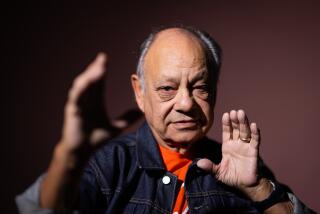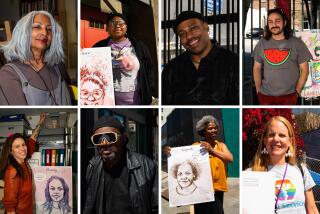Waiting for Recognition : Center Serves as a âFamilyâ Home to Chicano Artists
For more than a decade, the Self-Help Graphics art center on Brooklyn Avenue has provided a focus for Chicano artists in the heart of Los Angelesâ Eastside barrio. And, in a characteristic give-and-take with their community, the artists have, in turn, taught art to thousands in the surrounding neighborhoods.
Most Chicano artists in Los Angeles, including those who have begun their rise to international prominence, have gone through the centerâs doors. Some have found teaching jobs or studio space there; others have made use of the centerâs galleries, participated in community programs or in the annual Atelier, a 4-year-old silk-screen workshop that has afforded dozens of artists the opportunity to reproduce prints of their work for exhibition and sale.
On peeling gallery walls and in cramped art studios, color and imagination explode across canvas and paper in images of pre-Columbian gods, slick bathing beauties, ghostly soldiers of misfortune and magenta buffaloes roaming a psychedelic landscape.
Founded by Nun
Despite a history of indifference from the art establishment, Sister Karen Boccalero, the Franciscan nun who founded the center in the garage behind the house she shares with other nuns, anticipates the day when the communityâs artistic expression will gain widespread recognition.
âIt will be recognized, no doubt about it,â said Boccalero, who was raised on the Eastside and studied art at Immaculate Heart College. âThere are too many good Chicano artists, the expression is too vital. . . .â
Artist in residence Yreina Cervantez, 32, who teaches watercolor workshops at the center through a grant from the California Arts Council, is part of this first sizable wave of Chicano artists in Los Angeles.
âWhen my generation started out, there werenât many role models and no avenues for developing creativity,â she said. âNow we are reaching a certain maturity in our art and as persons. Chicano artists have developed their ideas politically while making a commitment to art and relating it to the community. And itâs up to us to pass on this awareness.â
Exposure in Community
For several years, artists from the center staffed a mobile art studio that exposed thousands in the community to Chicano art through workshops held at Eastside schools, parks and housing projects. The center once sponsored a Chicano literary journal and also became renowned for its community celebration of Dia de los Muertos, a traditional Mexican commemoration of All Souls Day.
Chicano artists say that such exchanges are an essential part of their art.
âArtists have a responsibility to share what they know with their community,â said Cecilia Castaneda Quintero, 37, a painter who has assisted with exhibitions and taught at several area museums. She said that her teaching experience at Self-Help Graphics, which also offered her a place to work, exposure to her culture and the camaraderie of other Chicano artists, marked a âturning pointâ in her life.
âItâs important to establish your connection with a community, itâs something most people are looking for,
and that we already have,â said Quintero, who calls that connection âa source of strength.â
Community involvement remains a tradition at Self-Help Graphics, despite dwindling resources for the arts. Self-Help Graphics, which receives most of its funding through grants and donations, has seen its annual budget shrink by one-third to about $90,000 in recent years, said Boccalero, who still administers the nonprofit organization. The center has had to limit its community programs, focusing its resources on services for working and emerging artists, she said.
But, the centerâs parking lot still serves as an informal after-school playground for neighborhood children who have become acquainted with the local artists. Sometimes the children drop in on workshops where Cervantes and others introduce young housewives, community workers and other young and older aspiring artists, to art--Chicano style.
Source of Information
For the artists, the center remains a key source of information and support. Through the center, they are kept aware of job opportunities, exhibits, competitions, grants.
âSelf-Help teaches artists how to make it out in the world . . . something you donât learn in art school,â said Virginia Torres, who credits her administrative experience at the center with helping further her career. It has included a stint at the White House as part of former President Jimmy Carterâs reorganization committee, and five years as a regional representative for the National Endowment for the Arts.
âFor many of us, Self-Help was our first professional experience,â she said. âAnd it wasnât just professional support, it was familia .â
This is another tradition that remains strong at Self-Help Graphics.
âOur whole community is filled with the attributes of culture and this is the center of it,â said Linda Vallejo, 33, an artist long associated with the center who has shown her handmade paper sculptures at exhibits across the state.
âBecause of Self-Help and the community I found here--artists, philosophers, dancers, writers, musicians--Iâve stayed in art,â Vallejo said, adding that the field can be particularly tough for women who, like her, must divide their time among a family, a job and their art. âWhen you find it, you realize itâs home and you stay.â
Matthew Thomas, a young black artist, who only recently became acquainted with the center when he was invited to participate in this yearâs Atelier, marveled at the cooperative spirit he has found there.
Nighttime Instruction
Anxious about working in an unfamiliar medium, Thomas said that another artist at the center recently stayed up most of the night, leading him step by step through the silk-screen process.
âThe professional world can be isolated, competitive, cold,â Thomas said. âBut here itâs like an extended family . . . artists come together and learn and support each other.
âMaybe there are other places that do this,â he said. âBut Iâve never experienced it before.â
Boccalero said she finds it difficult to explain Self-Help Graphicâs concept--as both an artists center and a community art organization--to funding agencies of the arts establishment. Similarly, she said, art dealers have trouble fitting Chicano art into a niche because of its vast diversity.
âItâs hard to categorize us . . . to explain us,â said Boccalero, who though of Italian heritage has come to identify with Chicano culture, too.
Consider the Chicano mural movement of the late 1960s and early â70s, she said, which involved âhundreds of people up and down the state, from 9-year-olds to 60-year-olds. Some were artists and others had never gone to art school. It was alive and expressive. It spoke to people, mirrored back to the community positive historical attitudes. And its impact was immediate.â
Motherâs Pride
Boccalero, who wears jeans and tweed jackets and often puffs on a cigarette as she speaks, her hands and arms in constant motion, downplays her role in the artistsâ âfamily,â speaking instead with a tough motherâs pride in the artistsâ accomplishments.
âChicanos have created some of the most substantial and innovative art--with more spirit--than most art created in the past 15 years,â Boccalero said.
âThe struggle of Chicano artists is to maintain their expression, their piece of reality . . . ,â she said. âAnd, to get the world to look and listen.â
Westside gallery owner Robert Berman is among a handful of Los Angeles art dealers who have begun to take notice. Berman, who has shown the work of Eastside artists at his B-1 Gallery in Santa Monica, said he is banking on Chicano art becoming a âworld-class art movement.â
He said he is one of the first among about a dozen small Westside galleries specializing in contemporary Los Angeles art to âjump on the bandwagon and say, âHey, there really is something happening out there (on the Eastside).â â Berman added that some art critics credit Chicano artists with shaping the style and imagery that is beginning to be associated with Los Angeles.
But for most emerging Chicano artists, getting the world to listen is still a difficult task.
Artist in Residence
Michael Amescua, one of a handful of artists in residence at the center, said that sometimes late at night while working alone in his studio, surrounded by the pre-Columbian images that spring from his imagination into steel and paper sculptures, he is filled with doubt.
Art dealers have told him that his artwork is unmarketable because buyers do not relate to the cultural imagery it projects.
But Amescua continues his work. âArtists have to follow their own path,â he said.
Upstairs, Roberto Delgado works in another small studio populated by life-size cardboard figures that he uses to create spray-painted images on large canvases. Delgado railed with wry humor at the East Coast-centered âart gameâ that, he said, dictates European standards, disregarding Chicano art rooted in Latin American reality.
Recently selected a finalist for a prestigious Fulbright award and one of the few Eastside artists whose work is shown in Westside galleries, Delgado said that âWestside people are afraid to come out here. They get nervous.â
The cramped studio, where a disheveled Delgado sits in an old armchair, sometimes staring at a television tuned to the dayâs football games, is not the Westsidersâ idea of an artistâs loft, he said.
âThen they see my work,â he added, âand they seem surprised.â
More to Read
The biggest entertainment stories
Get our big stories about Hollywood, film, television, music, arts, culture and more right in your inbox as soon as they publish.
You may occasionally receive promotional content from the Los Angeles Times.










